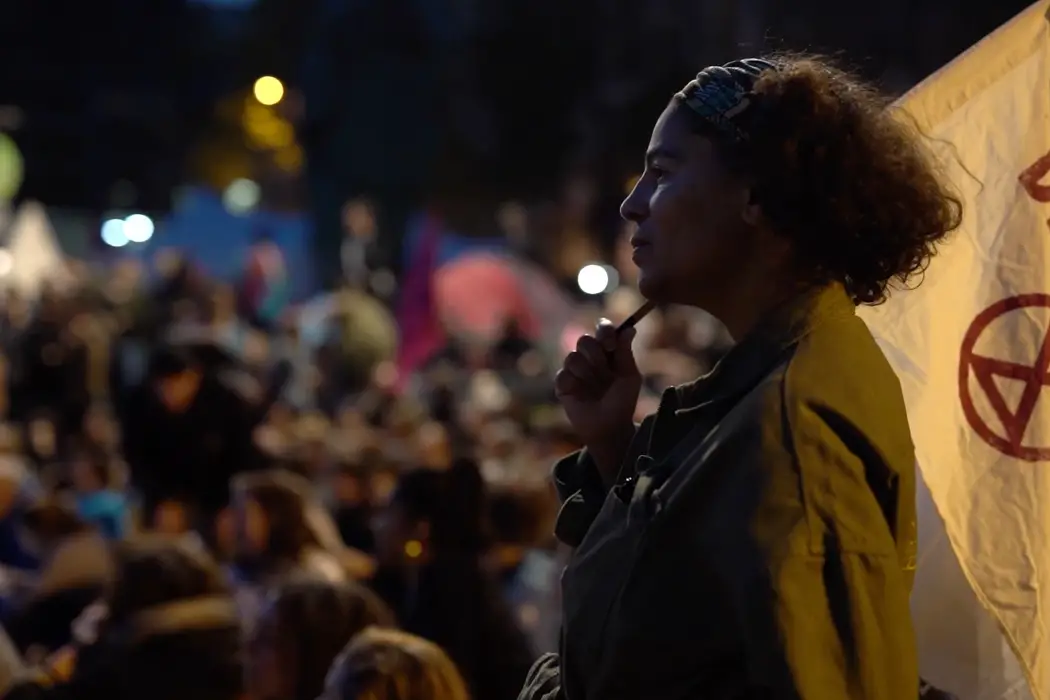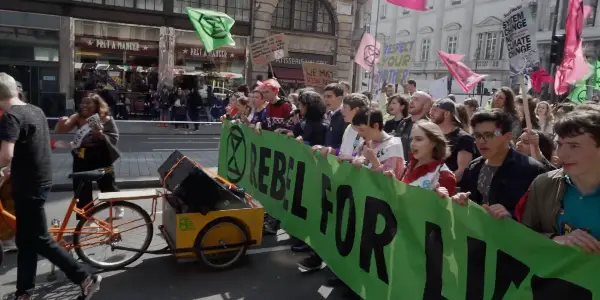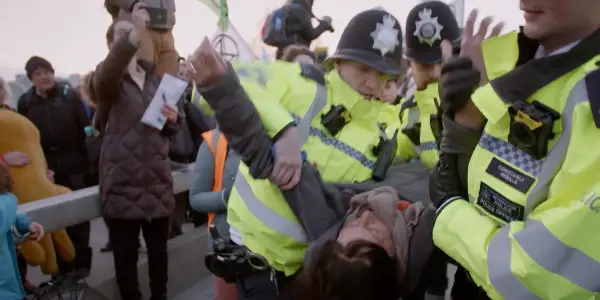CONSCIENTIOUS PROTECTORS: Trying To Save Us From Ourselves

Film critic, Ithaca College and University of St Andrews graduate,…
Since fifth-grade science class, most American students have had climate anxiety hammered into them by the (very well-made) sledgehammer of Al Gore’s An Inconvenient Truth. I wouldn’t be surprised if that monosyllabically named man and his deluxe PowerPoint presentation about the unholy crusade mankind is waging against the polar bears and their ice caps singlehandedly converted more people into environmentalists than any other force on the planet. Well, I mean, besides climate change itself. A number of such activists are profiled in Leigh Bloomfield’s Conscientious Protectors, though Bloomfield focuses not on polar bears and ice caps, but on organizers and protests — not on extinction itself, but on the rebellion against it.
In the broad spectrum of environmental documentaries, the British doc Conscientious Protectors shares far more in common with the festival darling Greta Thunberg doc I Am Greta than it does with a more challenging film like the brilliant Earth Liberation Front doc If a Tree Falls. The film is a profile-slash-promo film about the group Extinction Rebellion, which began in England in 2018 and has since spread across the world. The action of Bloomfield’s story crescendoes to, in its first act, and then depicts, in its second and third, a massive five-part demonstration in London to “hold the centre of London hostage.” At times, it has the war zone shock and camaraderie of something like the 2015 Oscar-nominated Ukraine documentary Winter on Fire, but this “story of a rebellion against extinction,” as it’s subtitled, doesn’t burn as hot as it ought to.
Man Versus Nature Versus Emma Thompson
The demonstration in question is laid out like a bank job in a good heist movie. The Danny Ocean here is Extinction Rebellion co-founder Roger Hallam, whose wispy hair, tucked into a bun, wrinkled forehead, crooked nose, and falcon stare establish him as a sagelike figure with a low tolerance for bullshit and a Billy Connolly – like croaky Scottish uncle demeanor. His job is to smooth-talk officials behind the scenes and plan demonstrations, while his boots-on-the-ground point person, co-founder Gail Bradbrook, is happy to roll up her sleeves and grab a bullhorn. The third co-founder, the rainbow-bearded Stuart Basden, and some other activists and organizers, flit in and out of the narrative as the movement gets underway.
After we meet our Danny Ocean and his team, the April 2019 demonstration is laid out. Some helpful map inserts, designed by Bloomfield and Philip Gooch, pinpoint the five spots across London the activists are planning to claim and hold until their demands are met. That includes that the government tell the truth about climate change, set the UK up for net zero emissions by 2025, and form a citizen’s assembly to propose more climate solutions.
It’s easy to imagine a Sorkinesque drama playing out amongst the bustling rooms of the Extinction Rebellion office, or perhaps a film that had taken some pages from Gore’s book and visualized for us what was at stake if our governments continued to do nothing. But Bloomfield and his team trust that their viewer comes to Conscientious Protectors already literate in climate science, and the film focuses squarely on the organization, protests, and timeline, from the planning to the execution to the inevitable crackdown by police 10 days later.

The structure of the film and what it chooses to follow are its biggest detractors. Many kids and casual activists are involved in the demonstration, yet we exclusively follow the top brass. The brief glimpses the film gives us of the youth movement suggest a livelier, more anarchic, more hopeful doc was possible, yet it just wasn’t what the film’s eight camera operators chose to follow with great detail. Documentaries are often made in the edit when narrative strands jump out from hundreds of hours of footage and talking head interviews, but given the now-four years between the demonstrations shown and the film’s release, the narrative we’re given is surprisingly uncomplicated.
We don’t have a layperson to follow into the organization, only the dogmatic activists at the helm. They’re a fun lot, though, and the exclusive, behind-the-scenes nature of the film is certainly one of its main appeals. Even cameos from Emma Thompson, who’s criticized for, as a celebrity, flying so often, and Thunberg herself don’t derail the film’s focus on the Extinction Rebellion activists, as though it’s saying, These people are so cool and their work is so important that we can barely afford to give one of the most respected British actresses of our generation mere seconds of screen time before we cut back to them.
Documentary Activism
It’s unfair to judge a documentary without engaging with the material the doc is trying to address. So here’s the poop, the skinny, the 4-1-1: Across the world, record-breaking temperatures are killing people, interrupting lives, and making whole parts of the globe unlivable. Extreme heat waves have become common in the UK, as have devastating floods. Indonesia is moving its capital because the old one is flooding with every storm, which didn’t use to happen. Rising tides and storms are increasing soil salinity, threatening crops. Low-lying island nations have decades left before rising ocean levels swallow them up. Some freshwater bodies like lakes and streams can no longer support wild fish or have algae bloom so out of control that they can hardly support anything. Deforestation, disease, and pollution are killing species at an alarming rate — frogs, dolphins, coral, and insects. Entire ecosystems are on the verge of collapse or have collapsed.
For all the criticism anyone can levy at Extinction Rebellion — and there are lots — at least they’re doing something to combat the climate emergency. Nobody in positions of power is interested in saving us from ourselves, in curbing emissions, and creating a sustainable future. Not unless they’re coerced by mass protests and political and economic pressure. Through that lens, the actions of Extinction Rebellion make a little more sense. Nothing gets a government to consider what a group’s protesting for when said protests cost them 10 days of hellish commutes in the country’s busiest city and a £16 million price tag for police activity. (It’s not cheap to arrest senior citizens protesting!)
When taken alongside films like If a Tree Falls, I Am Greta, or Kiribati documentary The Hungry Tide, this documentary makes a strong case for there not ever having been an effective environmentalist group. Maybe that’s true, or maybe that’s due to the film’s reticence to show the political and policy side of Extinction Rebellion’s charge. We never see negotiations take place while the group protests; for all we know, they shut down London for 10 days without ever giving the government demands.
Documentaries shouldn’t require a post-watch Google search just to clear things like this up, but it seems Extinction Rebellion was more focused on mass protests and making noise than meeting with members of Parliament and discussing solutions — which is fine! Discussions were underway to make a citizen’s assembly, and the government did wind up declaring a “climate emergency,” per the group’s demands, but declarations are not policy. The largest accomplishment the group can be credited for seems to be furthering discussion of environmental policies, allowing ambitious goals like “net zero by 2025” to be seriously debated rather than dismissed outright and getting ordinary British citizens to potentially consider environmental policies in elections. Not every climate activist group needs to be the Earth Liberation Front, after all.
Conscientious Protectors also depicts but fails to engage with several major shortcomings from the group — the organizers seem happy to let other people put their necks on the line yet are reluctant to participate in any “arrestable” activities; the movement seems to thrive on secrecy and duplicity, as when the youth coalition is repeatedly deployed to do things that could definitely get them arrested yet the organizers fail to tell them this; and the group’s happiness to coordinate with police and plan protests while communicating openly with them conflicts with the group’s smug detachment and insistence to not treat police like a real threat.

Maybe this is my American protest brain activating, but I have never been to a protest where the police were anything but an antagonistic force, a tool of the state. And I know that protests if done improperly, tend to become more like street parades than actual demonstrations. The Glasgow climate march for the 2021 United Nations Climate Change Conference had this exact vibe — plenty of performance with a paucity of action. The goal of Extinction Rebellion seems to be more in line with the performative aspects of protesting that I dislike — holding prayer and meditation for the climate, wheeling a “big pink vagina boat” into London (presumably as a grim reminder of rising sea levels), and hoping that arts and crafts stations and singers with ukuleles are enough to keep climate demonstrators entertained for over 10 days.
The movement’s goals are just and urgent enough, though, that criticizing the way it actually goes about trying to bring change feels extremely stupid. You’ve heard of rearranging the deck chairs on the Titanic — criticizing Extinction Rebellion feels like yelling at the people hauling out lifeboats because their uniforms aren’t tidy enough.
Little of this is the documentary’s fault, of course — except, it creates a sort of echo chamber effect to be presented with all this stuff with no recourse. The film could have done with more conversations with protesters and experts about not just climate problems in general and how the group is working to change them, but also the legitimacy of Extinction Rebellion’s methods. As it is, the film is more of a promo for the organization and its anarchic approach to protesting, which makes for a fine historical piece but left me short when it came to actually telling me anything deeper about the group or the serious problems it’s trying desperately to fix.
Conclusion: What Did We Learn?
Ironically, I’m writing this review from the window seat of an airplane. Dim city lights are visible through the clouds on the other side of the English Channel. Somewhere down there is London, and somewhere in there are the members of Extinction Rebellion, toiling away on their next climate protest.
Conscientious Protectors is not as radical as its subject matter. The folks at Extinction Rebellion are trying to make a difference any way they can — be it putting flowers on a bridge, occupying a subway car roof, or deploying kids to terrorize London. Their methods might be glib, questionable, and callous, but their fight is just, and I’m just glad there’s someone down there trying to change the way we treat our planet.
What do you think of Extinction Rebellion or their documentary? Comment below and let us know.
Watch Conscientious Protectors
Does content like this matter to you?
Become a Member and support film journalism. Unlock access to all of Film Inquiry`s great articles. Join a community of like-minded readers who are passionate about cinema - get access to our private members Network, give back to independent filmmakers, and more.
Film critic, Ithaca College and University of St Andrews graduate, head of the "Paddington 2" fan club.













